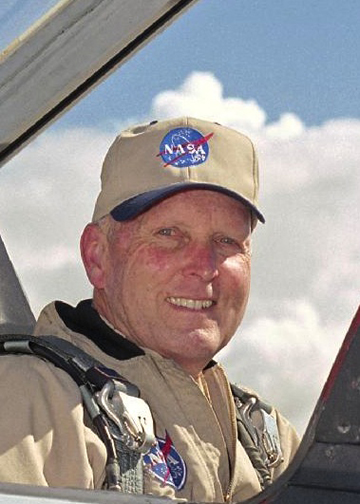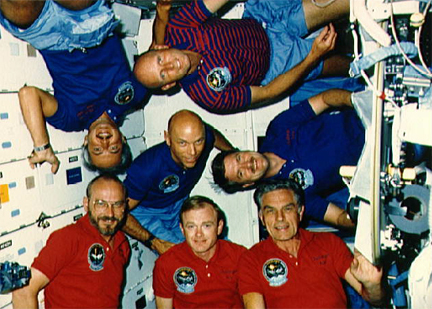C. Gordon Fullerton, legendary aviator-astronaut, dies
08/21/2013 08:11 PM Filed in: Space News | Space Shuttle
By WILLIAM HARWOOD
CBS News
Former shuttle commander C. (Charles) Gordon Fullerton, veteran of two space missions who also flew NASA's B-52 launch aircraft and was one of only two non-Russians to fly the Tu-144 supersonic transport during a legendary 50-year career, died Wednesday. He was 76.
A NASA spokesman said the aviator suffered a "severe stroke" in late 2009, spending the past three-and-a-half years in a long-term care facility in Lancaster, Calif., just down the road from Edwards Air Force Base where he flew countless missions.
During his long aviation career, Fullerton logged more than 16,000 hours flying time in 135 different types of aircraft, including the high-performance F-104 "Starfighter," the F-111, the F-15, F-16 and F/A-18 fighters and much larger jets, including KC-135s, the B-52, NASA's 747 shuttle transport jet and others.
He participated in the Air Force's Manned Orbiting Laboratory, or MOL, program until its termination in 1969 and then went to work for NASA, joining the support crews of four Apollo moon landing missions before serving as pilot during the first free flight of the agency's Enterprise shuttle prototype.
He went on to serve as the pilot of the shuttle Columbia for the program's third test flight in 1982 and he commanded a Spacelab science flight aboard Challenger in July 1985, logging 15.9 days in space during both missions.
During his second launch, one of Challenger's three main engines shut down prematurely because of a sensor failure in the only in-flight abort in shuttle history. Fullerton and pilot Roy Bridges, later director of the Kennedy Space Center, continued the climb to a lower-than-planned orbit and completed a successful mission.
Fullerton reported the engine shutdown in such calm tones during a brief call to mission control that reporters listening in did not immediately realize one of the hydrogen-fueled powerplants had failed.
"He was cool under pressure when it counted," a NASA official recalled Wednesday.
After leaving the astronaut corps in 1986, Fullerton spent 22 years as a test pilot at the agency's Dryden Flight Research Center at Edwards Air Force Base, retiring in 2007.
Fullerton's long career garnered numerous awards and honors, including the Ivan C. Kincheloe Award from the Society of Experimental Test Pilots; the Department of Defense Distinguished Service and Superior Service Medals; and the Air Force Distinguished Flying Cross.
He was inducted in the Astronaut Hall of Fame in 2005.
Born Nov. 10, 1936, Fullerton earned a master's degree in aeronautics from the California Institute of Technology in 1958 and joined the Air Force after a brief stint with Hughes Aircraft as a mechanical design engineer.
After graduating from flight school, Fullerton served as an F-86 pilot before transitioning to the B-47 bomber at Davis-Monthan Air Force Base in Tucson, Ariz.
A natural "stick-and-rudder man," Fullerton was selected to attend what became the Air Force Test Pilot School at Edwards Air Force Base, Calif., in 1964 and then moved to Wright-Patterson Air Force Base in Dayton, Ohio, where he was a test pilot with the Bomber Operations Division.
Between 1966 and 1969, Fullerton was part of the Air Force Manned Orbiting Laboratory, or MOL, program, which envisioned launching modified Gemini spacecraft, attached to a compact laboratory, for military reconnaissance missions.
The program was terminated in 1969 and Fullerton, an active-duty Air Force officer, was assigned to NASA. He retired from the Air Force with the rank of colonel in 1988.
According to a NASA news release, a funeral mass is planned for Saturday at Sacred Heart Catholic Church in Lancaster. NASA will hold a remembrance of Fullerton's life Monday.
CBS News
Former shuttle commander C. (Charles) Gordon Fullerton, veteran of two space missions who also flew NASA's B-52 launch aircraft and was one of only two non-Russians to fly the Tu-144 supersonic transport during a legendary 50-year career, died Wednesday. He was 76.
A NASA spokesman said the aviator suffered a "severe stroke" in late 2009, spending the past three-and-a-half years in a long-term care facility in Lancaster, Calif., just down the road from Edwards Air Force Base where he flew countless missions.
 |
| C. Gordon Fullerton, former shuttle commander and distinguished test pilot, died Wednesday after a long illness. He was 76. (Credit: NASA) |
He participated in the Air Force's Manned Orbiting Laboratory, or MOL, program until its termination in 1969 and then went to work for NASA, joining the support crews of four Apollo moon landing missions before serving as pilot during the first free flight of the agency's Enterprise shuttle prototype.
He went on to serve as the pilot of the shuttle Columbia for the program's third test flight in 1982 and he commanded a Spacelab science flight aboard Challenger in July 1985, logging 15.9 days in space during both missions.
During his second launch, one of Challenger's three main engines shut down prematurely because of a sensor failure in the only in-flight abort in shuttle history. Fullerton and pilot Roy Bridges, later director of the Kennedy Space Center, continued the climb to a lower-than-planned orbit and completed a successful mission.
Fullerton reported the engine shutdown in such calm tones during a brief call to mission control that reporters listening in did not immediately realize one of the hydrogen-fueled powerplants had failed.
"He was cool under pressure when it counted," a NASA official recalled Wednesday.
After leaving the astronaut corps in 1986, Fullerton spent 22 years as a test pilot at the agency's Dryden Flight Research Center at Edwards Air Force Base, retiring in 2007.
Fullerton's long career garnered numerous awards and honors, including the Ivan C. Kincheloe Award from the Society of Experimental Test Pilots; the Department of Defense Distinguished Service and Superior Service Medals; and the Air Force Distinguished Flying Cross.
He was inducted in the Astronaut Hall of Fame in 2005.
 |
| Fullerton poses with the crew of shuttle mission STS-51F, floating at the top of the frame in a red-and-black-striped shirt. (Credit: NASA) |
After graduating from flight school, Fullerton served as an F-86 pilot before transitioning to the B-47 bomber at Davis-Monthan Air Force Base in Tucson, Ariz.
A natural "stick-and-rudder man," Fullerton was selected to attend what became the Air Force Test Pilot School at Edwards Air Force Base, Calif., in 1964 and then moved to Wright-Patterson Air Force Base in Dayton, Ohio, where he was a test pilot with the Bomber Operations Division.
Between 1966 and 1969, Fullerton was part of the Air Force Manned Orbiting Laboratory, or MOL, program, which envisioned launching modified Gemini spacecraft, attached to a compact laboratory, for military reconnaissance missions.
The program was terminated in 1969 and Fullerton, an active-duty Air Force officer, was assigned to NASA. He retired from the Air Force with the rank of colonel in 1988.
According to a NASA news release, a funeral mass is planned for Saturday at Sacred Heart Catholic Church in Lancaster. NASA will hold a remembrance of Fullerton's life Monday.